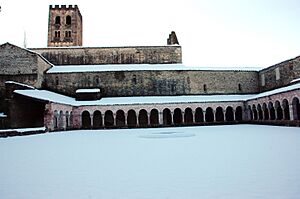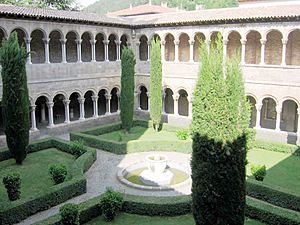Abbot Oliba facts for kids
Oliba (born around 971, died 1046) was a very important person in the history of Catalonia, a region in Spain. He was first a nobleman, known as the Count of Berga and Ripoll from 998 to 1003. Later, he became a powerful church leader, serving as the Bishop of Vic (1018–1046) and the Abbot of Sant Miquel de Cuixà. Many people consider him one of the key figures who helped shape Catalonia. He was likely the most important church leader of his time in the area that is now Spain and Portugal.
Oliba was also a writer. He and the monks in his scriptorium (a special room where monks copied books) at Ripoll wrote many works about their world. One of his most important achievements was translating Arabic writings into Latin.
Contents
Oliba's Family and Early Life
Oliba was born around 971 into a wealthy family. He was the third son of a Catalan count, which was a type of nobleman who ruled a region. Even though he came from a rich family, he decided to give up his possessions and become a Benedictine monk at the Monastery of Santa Maria de Ripoll. He had three brothers and one sister.
Oliba as a Count
In 988, Oliba's brother, Count Oliba Cabreta, became a monk and went to live at Montecassino. This meant Oliba had to take on his duties as a count. His brothers, Bernard and Guifré, inherited other lands, while Oliba received the areas of Berga and Ripoll.
From 988 to 1002, Oliba served as the Count of Berga and Ripoll. He often worked closely with his brother Guifré during this time.
Oliba's Church Life
Oliba was very active in the church and society. He strongly supported an idea called the Peace and Truce of God (in Catalan, Pau i Treva de Déu). This was an agreement to set aside certain days when no one would fight battles, and people seeking safety could find it in churches. In 1027, he signed an important agreement with other bishops and noblemen in Toulouges, France, to make these rules official.
Oliba was a very influential person. In 1023, King Sancho III of Navarre asked Oliba for advice because he wanted his sister to marry her second cousin. Oliba advised against it, but the king didn't listen. Oliba's letters show that he saw the kings of León as more powerful, like "emperors," while the King of Navarre was just a "king."
Oliba helped start or improve several monasteries, including Montserrat (in 1025), Fluvià, and Canigó. He also helped build or support many other churches, like the Collegiate Basilica of Manresa. He started the Assemblies of Peace and Truce, which later became the first parliaments (called corts) in Catalonia. He also made his own church at Ripoll more beautiful and rededicated it on January 15, 1032. He was a close advisor to Count Berengar Raymond I of Barcelona. With help from Countess Ermesinda, he rebuilt the cathedral of Vic, which was rededicated on August 31, 1038. Oliba passed away at his monastery in Cuixà in 1046.
Monk and Abbot
In August 1002, when Oliba was 31 years old, he officially became a monk of the Benedictine Order at the Monastery of Ripoll.
In 1008, after the previous leader, Abbot Seniofré, died, Oliba was chosen to be the new abbot, or leader, of the monastery. A few months later, he was also chosen as the abbot of the Monastery of St. Miquel de Cuixà. Oliba believed that monasteries should be stricter and more disciplined.
By 1009, Oliba had become quite well-known. He was also elected abbot of Sant Martí del Canigó. Other monasteries, like Sant Feliu and Sant Sadurní Tavèrnoles, liked his way of running things.
Oliba spent a lot of his time and energy protecting the property and rights of churches from attacks by noblemen. In 1011, he traveled to the Vatican to meet the leader of the Roman Catholic Church, Pope Sergius IV. He received several "papal bulls," which were special orders from the Pope, for his monasteries. These orders were very powerful because the Pope, who people in the Middle Ages believed was God's representative on Earth, declared that the monasteries and their lands were under the protection of St. Peter. This meant that attacking a monastery was seen as an attack against the Pope's own authority.
Santa Maria de Ripoll
In the late 900s, Catalonia became an important center for culture and art. People there had access to Arabic science and knowledge. The places where monks copied and wrote books, called scriptoria, became some of the best in Europe.
Ripoll had the most important scriptorium in Catalonia. With knowledge gained from Ripoll, Pope Sylvester II helped bring Arabic numbers, the idea of zero, and the astrolabe (a tool for astronomy) to Europe. During Oliba's time, the library at Ripoll grew a lot. Along with the library at Bobbio, it became one of the most important libraries in the Christian world during the Middle Ages.
Sant Miquel de Cuixà

Oliba made many changes to the buildings of this monastery. He had a walkway built around the main worship area with three rounded sections. He also built a dome over the altar and a crypt (an underground room). He added the Nativity Chapel, the Chapel of the Trinity, and two tall towers, though only one of them is still standing today.
Sant Martí del Canigó
The monastery of St. Martí del Canigó was started by Oliba's brother, Count Gifré II of Cerdanya-Conflent. Gifré took an old church at the base of Mount Canigó and turned it into an important monastery.
In 1009, this church and its group of monks were made up of monks from Cuixà. Abbot Oliba managed it through his community until 1014. By then, it had enough monks to choose its own abbot.
Gallery
-
Abbot Oliba, who helped found Santa Maria de Montserrat Abbey
- Oliba at Wikisource
See also
 In Spanish: Abad Oliva para niños
In Spanish: Abad Oliva para niños







